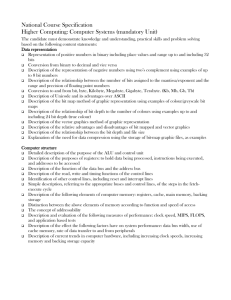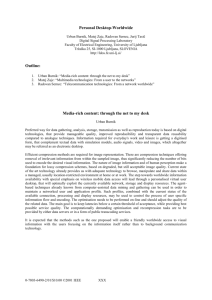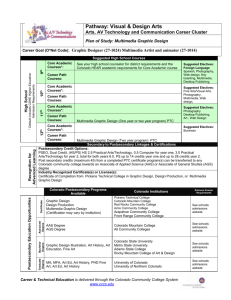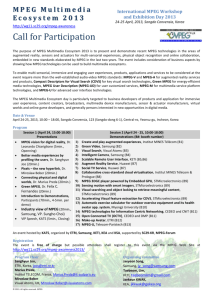Multimedia – Revision (blank)
advertisement
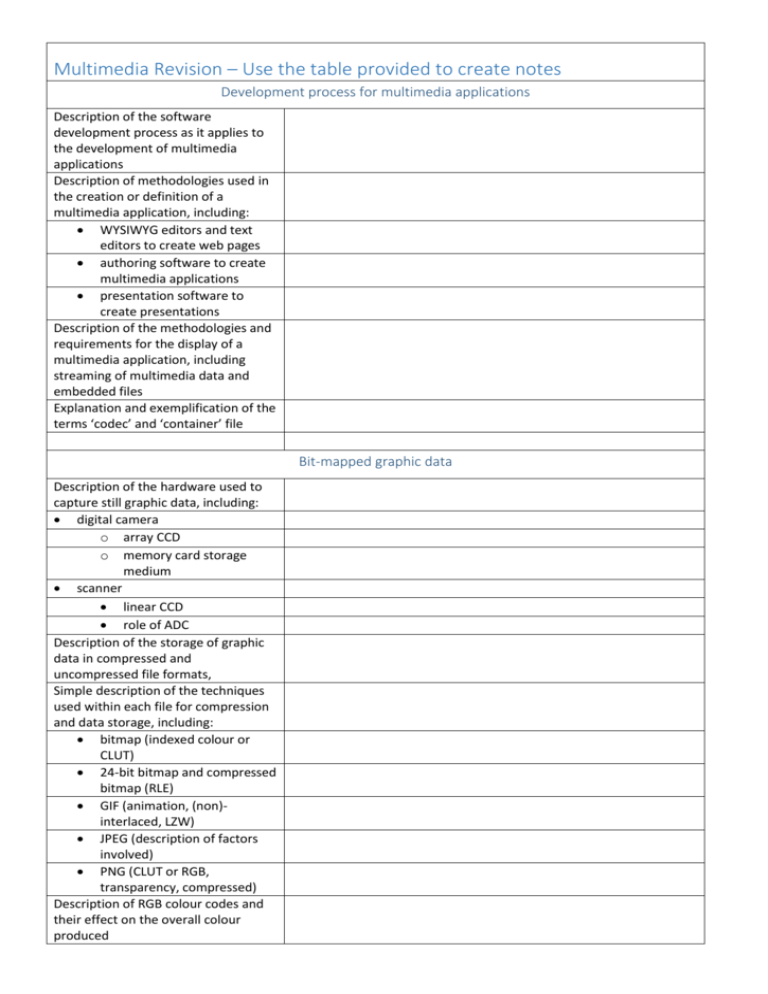
Multimedia Revision – Use the table provided to create notes Development process for multimedia applications Description of the software development process as it applies to the development of multimedia applications Description of methodologies used in the creation or definition of a multimedia application, including: WYSIWYG editors and text editors to create web pages authoring software to create multimedia applications presentation software to create presentations Description of the methodologies and requirements for the display of a multimedia application, including streaming of multimedia data and embedded files Explanation and exemplification of the terms ‘codec’ and ‘container’ file Bit-mapped graphic data Description of the hardware used to capture still graphic data, including: digital camera o array CCD o memory card storage medium scanner linear CCD role of ADC Description of the storage of graphic data in compressed and uncompressed file formats, Simple description of the techniques used within each file for compression and data storage, including: bitmap (indexed colour or CLUT) 24-bit bitmap and compressed bitmap (RLE) GIF (animation, (non)interlaced, LZW) JPEG (description of factors involved) PNG (CLUT or RGB, transparency, compressed) Description of RGB colour codes and their effect on the overall colour produced Calculations using the relationship: File Size = pixels x colour depth (bits) Calculation of number of pixels from height, width and resolution Explanation of the following image related terms: dithering anti-aliasing increase resolution (resampling) Description of features of graphics cards involved in displaying 2D graphics, including: role of DAC role of GPU/DSP (to allow effects to be applied by hardware) Digitised sound data Description of sound card in its use to capture sound data including role of ADC Description of the storage of sound data in compressed and uncompressed file formats, Simple description of the techniques used within each file for compression and data storage, including: RAW (PCM) RIFF (ADPCM) (including WAV) MP3 (description of factors involved) Description of the following terms in relation to audio files: bit-rate to describe data throughput for a sound file normalising sound files Calculations using the relationship: File Size (bytes) = Sampling Frequency (Hz) x Sound Time (s) x Sampling Depth (bytes) x Channels Explanation of the following sound related terms: clipping stereo, surround sound fade Description of features of sound cards, including: role of DAC role of DSP (to allow hardware decoding of sound files) Video Data Technical description of hardware required to capture digital and analogue video: digital video camera (array CCD) web cam (array CCD) video capture card (role of ADC and role of DSP to allow hardware encoding of data stream including into MPEG format) Description of the storage of video data in compressed and uncompressed file formats Simple description of the techniques used within each file for compression and data storage and the inclusion of sound within the file, including: uncompressed AVI MPEG (description of factors involved) Description of term bit-rate to describe data throughput for a video file Calculations using the relationship: File Size (bytes) = pixels per frame x Colour Depth (bytes) x Video Time (s) x Frame Rate (fps) Description of the main features and applications of video editing software with multiple clips, including: timeline transition sequencing Description of features of graphics cards for output of video, including: role of DAC role of DSP (to allow hardware decoding of data stream including MPEG files) Vector Graphics Data Description of features of vector formats: object oriented data storage more storage efficient than bitmap storage output quality matches hardware capability conversion to bitmap formats Description of common attributes of vector graphic objects: drawing (shape, position, size, rotation, line, fill) 3D image (shape, position, size, rotation, texture) Description of basic features and structures of vector graphic file types, including methods used to implement common attributes listed above for these file types: SVG VRML/WRL Synthesised sound data Description of common attributes of notes stored as MIDI data instrument pitch volume duration tempo Description of advantages and disadvantages of storing sound as MIDI data Implications of the use of multimedia technology Description of trends and changes in contemporary technologies that facilitate the convergence of technologies in relation of multimedia capabilities, including: communications buses wireless standards increasing bandwidth including USB Firewire WiFi Bluetooth storage technologies decreasing size and price increasing capacity including optical magnetic holographic processor increasing power display technologies including real and virtual 3D displays flat displays

